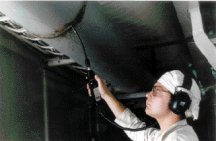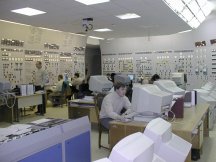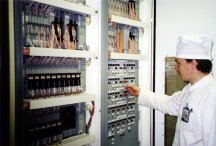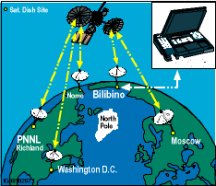Important Note: This website contains historical data from the INSP project. As of 2004 the site is no longer maintained and certain sections do not work correctly.
 |
Program Overview Page 7 of 8 |
 |
Timeline
1986
April A nuclear accident destroys Ukraine's Chornobyl Unit 4 reactor, focusing
worldwide attention on the dozens of Soviet-designed reactors that continue to operate (for more information).
1992
July At a conference of G-7 nations in Munich, the United States agrees to support cooperative work to reduce risks at Soviet-designed nuclear power plants in Ukraine, Russia, Bulgaria, the Czech Republic, Hungary, Lithuania, and Slovakia.
September A multinational working group convenes to begin planning safety training for nuclear power plant personnel.
1993
May The first U.S. training course for nuclear power plant personnel is taught at training centers in Ukraine and Russia.
August Using U.S. technology and materials, workers begin sealing leaks in the radiation confinement system at Russia's Kola plant.
1994
March Bulgaria's Kozloduy plant receives U.S.-manufactured firefighting equipment.
December Czech specialists complete a probabilistic risk analysis at the Dukovany plant, identifying conditions that could damage the reactor fuel core. Dukovany staff begin modifying the plant's operating requirements to reduce the risk.
1995
January Personnel from Soviet-designed reactors begin visiting nuclear power plants in the United States to observe reactor safety practices in action.
Spring A control room operator at a Soviet-
designed reactor uses skills developed
in U.S. training to prevent a nuclear
accident.
1996
After observing U.S. reactor personnel being trained to handle emergencies, managers at Russia's Balakovo and Ukraine's Zaporizhzhya plants each add an additional reactor operator per shift to monitor critical safety functions.
January
 Fire detection equipment like that delivered to the Leningrad plant. |
March The first symptom-based emergency operating instructions developed by U.S. and Russian experts are implemented at the Novovoronezh plant.
Russian regulatory personnel begin extensive training with U.S. experts to improve their oversight of nuclear power plants.
April In partnership with the United States, Ukraine's President Kuchma signs a declaration establishing a scientific center to focus on nuclear safety and environmental issues at Chornobyl and throughout Ukraine.
May Workers install a reliable, seismic-resistant emergency power system at Russia's Kola plant.
After restarting one of its two nuclear power reactors in 1995, the Armenia government begins working with the United States and the international community on cooperative safety projects.
August The United States completes the delivery of pipe lathes to the five plants with RBMK reactors. The lathes are used for precision repair of reactor coolant piping.
1997
March
 Ultrasonic inspection equipment in use in Ukraine. |
July Experts at the International Chornobyl Center for Nuclear Safety, Radioactive Waste and Radioecology complete their first technical project--a risk analysis. Other collaborative projects are under way.
Ukraine and the G-7 nations approve the Shelter Implementation Plan, which details measures to prevent collapse of the shelter around Chornobyl Unit 4 and safely seal the ruined reactor. The United States provided the primary technical support for developing the plan.
|
Shelter around Chornobyl Unit 4. |
September Control room operators at Kursk Unit 2 begin using a safety parameter display system that gives them crucial information for controlling the plant in the event of an accident.
October Technicians at the five sites with RBMK reactors are maintaining crucial safety systems with valve-seat resurfacing equipment.
The U.S. Department of Energy agrees to work with the nation of Kazakhstan to improve safety at its Soviet-designed nuclear power reactor.
Workers complete a project that began in 1993 at Russia's Kola plant--sealing leaks in the radiation confinement system and installing confinement isolation valves.
December
 Simulator at Khmelnytskyy plant. |
1998
January Russia's Novovoronezh Unit 3 becomes the first Soviet-designed reactor to implement a full set of symptom-based emergency operating instructions.
March Zaporizhzhya workers inspect 1,500 steam generator tubes with remotely operated eddy-current equipment supplied by the United States.
Hungarians trained by U.S. experts to analyze the reliability of operator actions agree to support Czech specialists in a similar analysis.
Simulator at Khmelnytskyy plant.
March Ukrainian control room operators at Chornobyl's Unit 3 reactor implement symptom-based emergency operating instructions.
April Ukrainian and international specialists begin carrying out the Shelter Implementation Plan at Chornobyl.
May Workers at Chornobyl Unit 3 install a fire-resistant coating material on the turbine hall's structural steel. In the event of a major fire, the coating will help prevent a collapse of the roof.
June
Workers at Chornobyl stabilize a ventilation stack damaged by the 1986 accident. The accomplishment marks the first resolution of a significant safety issue stemming from the disaster (for more information on vent stack).
Working to stabilize a ventilation stack at the Chornobyl plant.
July Bulgaria's Kozloduy plant and Lithuania's Ignalina plant establish configuration management programs.
Ukrainian technicians begin installing a U.S.-built monitoring system inside the shelter to determine the number of fission reactions occurring in the nuclear fuel mass.
The governments of Ukraine and the United States agree to create the International Radioecology Laboratory as a new subsidiary of the International Chornobyl Center. The laboratory will research the effects of radiation on plants and animals.
September
 Control-and-protection system panel at Ignalina Unit 1. |
Ukraine's Khmelnytskyy and Chornobyl plants and Russia's Novovoronezh plant now have simulators to train control room operators.
Maintenance technicians at Chornobyl are using insulation analysis equipment and infrared cameras to detect hazards in electrical systems.
After U.S. training, a Lithuanian company manufactures reliable replacement modules for the aging control-and-protection system at Ignalina. With U.S. support, a new backup control-and-protection system is installed at Ignalina Unit 1.
November U.S. personnel begin training Kazakh specialists to conduct nuclear safety analyses.
December Control room operators at four plants in Ukraine and two plants in Russia now have safety parameter display systems.
Specialists at the South Ukraine plant and Russia's Leningrad plant complete preliminary probabilistic risk analyses, assessing events that could lead to damage of the reactor core.
The United States has delivered equipment and training to protect workers at the Chornobyl shelter from radiation and industrial hazards.
1999--Planned
 Communications system for Bilibino plant. |
To begin permanently shutting down and deactivating the Chornobyl plant, workers will defuel reactor Unit 1.
Chornobyl workers will complete the construction of a heating plant to maintain reactor safety systems during the deactivation process.
A U.S.-built, radiation-hardened robot will enter a room in the Chornobyl shelter to survey its structural conditions and demonstrate whether this technology can be used in the shelter.
 Replacement heat plant for Chornobyl. |
Russia's Bilibino plant will receive high-priority maintenance equipment.
Russian specialists will complete a safe-shutdown analysis at Smolensk, identifying ways to reduce the plant's most dangerous fire risks.
Specialists at the Kola Unit 4 reactor will complete a preliminary probabilistic risk analysis, assessing events that could lead to damage of the reactor core.
Control room operators at six more plants in Ukraine and Russia will have safety parameter display systems to give them crucial information for controlling the plants in the event of an accident.
U.S. and Kazakh specialists will develop technical strategies for shutting down the reactor at Aktau.
The Armenia plant will have upgraded steam isolation valves, an emergency cooling water system, and a safety parameter display system.
Ukrainian specialists will define strategies for managing the nation's spent fuel.
Zaporizhzhya will begin using a dry-cask storage system developed through U.S.-Ukrainian cooperation.
| Summary | Key Accomplishments | ||
| Introduction | Performace Measurement and Future Directions |
||
| Historical Issues and Reactor Types | Timeline | ||
| Reducing Risks | Contacts |
 |
Program Overview Page 7 of 8 |
 |